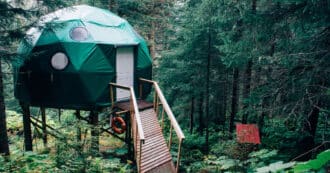By Sydney Cohen – Social environmental science is studying how we interact with the environment around us and how a person responds to his or her environment. Social ecologists look at an overall picture of our societal systems and look at how individual, collectives and institutions interact with one another. Social ecology allows a broader view of collective problems.
Bronfenbrenner’s Ecological System
Urie Bronfenbrenner was critical of previous social-ecological theories on development. He claimed that the study of children in unfamiliar confined laboratories, often with a stranger, was ecologically invalid.
His thesis was entitled Ecological and System Theory (EST), which is based on dynamic interactions between environments and the developing child. His perspective shares some similarities with Albert Bandura’s Social Learning Theory and Lev Vygotsky’s Sociocultural Theory, in which environmental context is explicitly or implicitly considered as affecting child development.
In creating the EST, Bronfenbrenner acknowledged that many aspects of a developing child’s life interact with each other.
Urie Bronfenbrenner developed the Ecological Systems Theory (EST) to explain how societal characteristics and structures interact and in turn affect human development. According to the theory, children tend to often find themselves embedded in different environments from the smallest ecosystem at home, to the larger system of education, and finally to the largest system that includes society and culture.
The different ecosystems in each child’s life both interact and influence each other according to Bronfenbrenner. The philosophy emphasizes the need to study the children in multiple environments, also known as ecological systems, in order to learn more about and understand their development.
The Ecological Systems Theory Model
The four systems which Bronfenbrenner proposed have roles, standards and rules derived. The first system is the microsystem and the second is the mesosystem. The third one is called the exosystem which does not directly affect children but can affect microsystems. The outermost system of children’s development is not directly affected by the macrosystem though it can be in contact with all social, economic, and political systems.
These four systems that construct EST, take into account the effects of these social systems and influences on the child and human development. In the context of the system, many social factors influence the development of children in various important ways such as behavior and interaction, for example.
The Microsystem of The Ecological System
Bronfenbrenner’s theories say that the microsystem is the most immediate and smallest environment where children live. The microsystem consists of the daily home, daycare, school environment as well as community environment.
Microsystems are people, groups, and organizations that are most directly influencing an infant’s development. For instance, people such as teachers, family members, neighbors, or religious institutions should be included.
How these groups interact with these children has an impact on their growth. The particular characteristics of a certain child in life including his/her temperament play a part in how he/she is treated. Positive interaction and relationships will positively benefit the children’s development.
The Mesosystems of The Ecological System
The mesosystem in Bronfenbrenner’s EST is the relationship and interactions between the different microsystems in which the child finds themselves. It involves connections between the home and school, between peers, group, and family, and between family and the community.
According to Bronfenbrenner’s Ecological Systems Theory, parents are actively involved in children’s social friendships by inviting their children’s friends over to play, and showing positive reactions to their child’s friends. Moreover, if one openly criticizes a child and dislikes his or her peers, they’re likely to develop a disequilibrium and conflicting thoughts that could lead their child to negative development.
The Exosystems of The Ecological System
Environments can still interact with their children’s growth in ways that may not directly affect them. For example, if a father gets constantly mistreated by a boss at his job, he can take this stress away from work and may take it out on his children at home.
Many of these places within an exosystem may be children’s workplaces or the homes and neighborhoods where they live. The exosystem involves the linkages that could exist between one and several settings that may not directly contain the developing children. However, these environments will affect child development indirectly, according to Bronfenbrenner’s analysis.
The Macrosystems of The Ecological System
The macrosystem is generally an influencer of the culture which influences the development of the child in the macrosystems and the mesosystems. It includes things like socioeconomic status, ethnicity, race, and geographical location.
The Chronosystem of The Ecological System
The chronosystem is social science’s way of describing change during their life span. It can include socio-historical situations which influence a person’s development. One example of this is how the birth of new siblings, divorce and relocation all have major effects on children.
According to a majority of studies, children will be negatively affected in the first year after a parent’s divorce. In the years afterward, the child will discover which relationships between family members became more stable and acceptable.
A Critical Evaluation of The Ecological System
EST provides an integrated approach to child development. Paat (2013) thinks about how Bronfenbrenner’s theories could be useful when studying immigrant children. They suggest immigrant children’s experiences are likely shaped by their cultural diversity across the different ecological systems.
An understanding of these children’s ecologies can improve child welfare services for them. There is however limited research studying mesosystems, and current research mainly focuses on interactions among neighborhoods or within the child’s family.
EST supports teachers and school administrators in developing educational environments appropriate for students and their own needs and character traits in addition to culture and society. This model supports parents in educating their children. It encourages parents to help children choose friendships and find good schools.

Research is also able to write questions from the components or concepts of the EST. Further, the four levels of EST can be combined as research tools to frame qualitative, quantifiable, and mixed research.
To examine the factors of obesity in overweight children with disabilities, Walker (2019) used an EST framework. The study focused on how layers of an ecological system/environmental system negatively affect kids with special needs such as weight and obesity. Microsystems like school, home, and extracurricular activities can influence health through physical activities and food selection.
The study also dealt with the governmental culture and religious beliefs. Within the field of language teaching, Mohammad Abadi used an ecological framework to analyze what factors influence language teachers at different levels. The ecological systems affect language teaching, and in turn, the learners.
The Ecological Systems Theory to Understand Human Development
In child development studies, the EST was used to describe infants’ initial development influenced by personal, social, and political conditions. Currently, the EST is well-applied to various domains. Schools may use EST to improve their students’ achievements and cater their teaching to best fit the students’ needs.
Ecological systems theory indicates that human development depends on various types of environmental systems. This theoretical theory assists us to understand what causes humans to behave differently, by looking for patterns that contrast behavior at home with behavior at school or work, for example.
Religion and Social Ecology
As Vernon Reynolds and Ralph Tanner describe in their book, The Social Ecology of Religion, “religions have down-to-earth functions in the control and management of the main events of the human life-cycle-birth, marriage, death, and the events in between.” Protecting our children must be a key part of our religious practices. Our future depends on it.
* Featured image source






